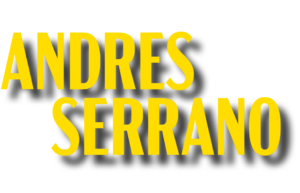

"Old Glory I" 1920's American 48 Stars Flag
Infamous
2019
"Old Glory I" 1920's American 48Stars Flag
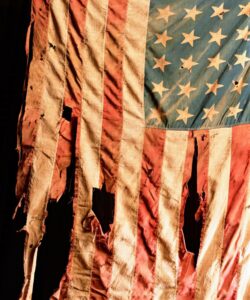
Hello, everyone. My name is Andres Serrano. I’m an artist, born and raised in New York City. So, I identify as being part of an American story. And even though I take pictures, I’ve done other things. And so, I don’t call myself a photographer, but an artist. And I hope after seeing my work, you agree that you’ve learned something about me and my story.
Old glory is actually an old term for the American flag. This particular flag is 48 stars. It means that at the time, there were 48 states. And as you notice, the flag is tattered. It’s frayed. It’s old. It’s been beaten by the wind, the rain. And to me, it symbolizes Old glory, meaning it’s the American flag. It’s a symbol. And America being the symbol of democracy, like the flag, has had its ups and downs and has taken a beating.

Jack Rainmaker,
Munsee Lenape
Native Americans
1996
Jack Rainmaker, Munsee Lenape
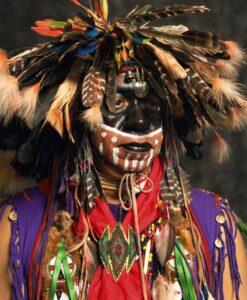
With this series, I wanted to take a look at Native Americans, and for me, it was more interesting to photograph Native Americans in some sort of native clothing. So I went to several Native American ceremonies and pageants where they dress up in traditional costumes. When I say costume, I mean clothing because it’s real. It’s just traditional. And so they dress up, maybe they don’t dress like this anymore. But for these pageants and ceremonies, they dress up. And oftentimes I want people to dress up because I photograph people as people, but many times they’re symbols. And the symbols need some sort of uniform.

Wunmi Fadipe, Sales Assistant at Investment Bank
America
2002
Wunmi Fadipe, Sales Assistant at Investment Bank
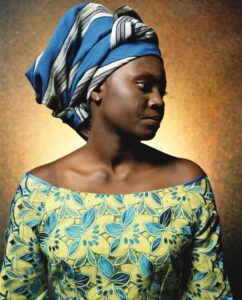
I did the America series as a result of September 11th because I felt we have been attacked as the enemy. And so it occurred to me to do a series which eventually became a book of who the enemy is, meaning as an American, as someone born and raised in New York City. I have like everyone else, my own version of what America is. And so I went about and spent three years photographing people from all walks of life that inhabit America.
Some of the first portraits were one of an American airline pilot. Another one of a man who was a Sikh who looked like he had a long beard, a turban, so it could have been Taliban, you know. Also soldiers, police and firefighters. I photographed two firefighters that had been digging through the rubble at the World Trade Center for months. And when I photographed them, not only did they have a lot of dust and dirt on their uniforms, they also showed fatigue as a result of not only going through all that rubble for months, but also the loss that they felt of their own people, of their own citizens, of the Americans who died in September 11th.
So that’s the initial inspiration for America.

Donald Trump
America
2004
Donald Trump
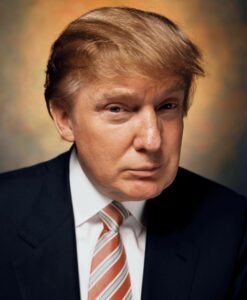
In 2004, Donald Trump, for me, represented the American dream. Now, Donald Trump in 2004 was not the same person you see today when as a president, as a former president and as a contender again for the presidency. He was not as divisive, but Donald Trump was always full of opinions. And because of that, many people thought he was an asshole. But one thing I can say about Donald Trump up until that point, if you look at the history of Donald Trump, he spent his whole life promoting himself, his casinos, his products, his name. I mean, he was very successful in the sense that when Donald Trump became president, it was because he was a household name. People knew him for decades. And so it made sense to me that Donald Trump, who can win people over, won America over.
I remember not saying much to Trump at the time that I took his picture, but I often do that when I photograph someone, particularly when I know they have limited time. And also, in the case of Donald Trump, I knew that if I said something that bored him, he would jump out of his seat and leave. And so I said nothing. And because of that, I got 30 minutes out of him, which is a long time.

Bertha
Nomads
1990
Bertha
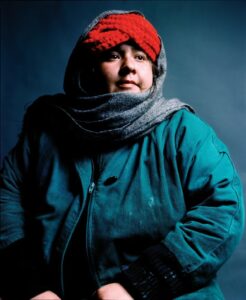
All of the Nomads, including Bertha, were portraits that I did in the subways late at night. And I had two assistants, I had a backdrop, I had lights, and I would have to photograph very, very quickly. I had to work very quickly. The police, because I didn’t have a permit, the police would let me finish my work, but the transit authority inspectors were very hard ass about it. They would throw me out immediately when they caught me there. And I felt like these people, they live outside the system, so as an artist, I can’t go looking for permission to photograph the homeless in the subway. So I too was acting on my own. Bertha, actually, I got from the streets late at night. I did my portraits around midnight, and afterwards, after midnight. Bertha, I got her to Tompkins Square Park and I remember we took her to the subway because we photographed in the subway. And I explained that I would pay her and that I wanted to take a portrait as she was. She made me smile when she said, ‘it’s not going to be naked. Right?’ I said, ‘No, it won’t be naked’.

Mary
Nomads
1990
Mary
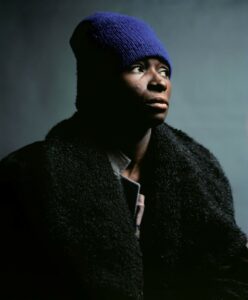
I’ve been an artist, but I’ve also been a collector for many years and I collect a particular thing, period, 17th century or earlier, furniture, paintings, sculptures, you know, works that were made during the Renaissance, even some mediaeval works I have. So I understand the need to collect. And yes, in a broader sense, I also collect people, I collect subjects, I collect ideas.
And so when I do a series, for instance it’s not just one person, it’s not just one subject. I do many things, just like when a collector starts collecting, they don’t just collect one item. They collect many items of the same thing many times. But, you know, it’s a series of things they collect. And so, yes, I’ve collected these all my life.
I’ve been asked perhaps more than once during a lecture, “how do you light your subjects?” And I explain with lights, you know, I put, I usually there’s three lights, one in the middle and one to the side, one to the other side. And so what I usually ask is I either tell people, look straight ahead, look to the right or to the left. I mean, my talent, I think, comes from the fact that I do the same exact thing almost every time. But by changing the concept, the lighting, the backdrop and the subject, it becomes something else.

Signs of the Times
2014
Signs of the Times
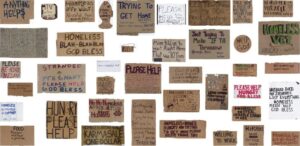
These are the Signs of the Times, and these are the signs that homeless people use when asking for money on the street. At some point, you know, in that year, I became aware of how many homeless there were in New York City, more than I had ever seen before. And I was drawn to the signs, because there were stories. Every sign was a story. And so I spent, I think, two months walking around the streets of New York City every day, sometimes late at night, looking for signs to buy. And I would tell everyone the same thing. I would say, “listen, I’m an artist and I see things”. And one of the things that I see is people with these signs. And for me, every sign is a story. “Can I buy your story?” And I think they all said yes, except for one person.

"Black Dolls - Larry" Vintage Rag Doll
Infamous
2019
"Black Dolls - Larry" Vintage Rag Doll
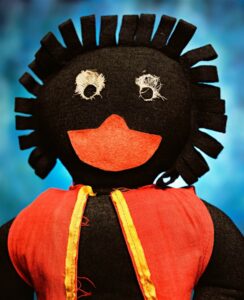
Infamous is about America’s History. It hasn’t been a pretty picture sometimes. And even though America has done things that were at the time, not legally crimes, oftentimes they have been crimes against humanity. And America’s history with people of colour, starting with Native Americans who they conquered, sometimes killed and whose land they took. You know, it’s bordered on infamous or outrageous behaviour. And that has extended to black people, brown people, Asian people, all kinds of people who America felt they had the right to subjugate, discriminate against and ridicule in the event that they couldn’t do anything else to them.
Racism has always been part of America’s history. It’s not only in the past. It’s in the present. It’ll continue in the future because America is divided in many ways, particularly along racial lines. And so America is the great experiment, the great experiment of democracy as a melting pot.

“X” Malcom X Car Air Freshener Circa 1970’s
Infamous
2019
“X” Malcom X Car Air Freshener Circa 1970’s
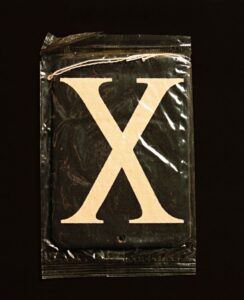
Well, you know, if we’re going to talk about infamy, there’s no greater act of infamy than killing someone illegally and taking the law into your own hands. And I’m talking about killing by ordinary citizens, killing by people who killed you only because of the colour of your skin. And so the Black man lynching picture is a postcard that was sent out in the mail at the early 20th century. And, you know, it was, nobody thought of it. I mean, that’s the extent of the racial prejudice and intolerance that went not only when you do it, but when you go around bragging about it.
Malcolm X was a symbol and a leader of his time. Like Martin Luther King, but even more radical. And Malcolm X was not loved, as beloved as Martin Luther King. And so Malcolm X, it’s only fitting that, you know, as a dissident, you know, fighting injustice, particularly black injustice, that Malcolm X should be part of Infamous. Now, in this particular case, Malcolm X is represented by a car air freshener, which came out in the late sixties. I don’t know what’s the bigger thing : is the fact that I’ve included Malcolm X as a symbol of racial injustice, but the fact that or that he’s been turned into a car air freshener.

Klansman, Knight Hawk of Georgia IV
The Klan
1990
Klansman, Knight Hawk of Georgia IV
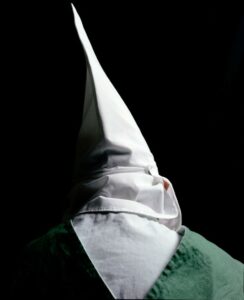
The fact that the KKK is known as a racist organization, that was of interest to me. Oftentimes, one thing leads to another. A picture leads to another picture. The KKK, I did immediately after doing the Nomads. I was very happy with the Nomads and I wanted to continue doing portraits. But then I thought, I want them to be unusual portraits. And I thought, well, if someone had had a mask, that would be a very unusual portrait, because a mask usually does the opposite of what a portrait is meant to do. A mask conceals rather than reveals. And when I thought of mask people, I immediately thought of the Klan and of course, because I’m not white, I’m Hispanic, you know, it was a challenge for me to work with them, but more important for them to work with me.
The only time that I felt it all threatened or not safe is when I went to a Klan rally. As soon as I got there, I was surrounded by about 30 skinheads who told me, “you’re not white, you’re not safe here. You have to get out immediately.” And that was the only time I felt hostility. But it wasn’t from the Klan, it was from these skinheads. The racism around me, the hate that I felt, felt around me was so intense that I didn’t feel comfortable talking to anybody. They became symbols and they assumed the power that they didn’t have without the clothes.

Dread
Early Works
1987
Dread
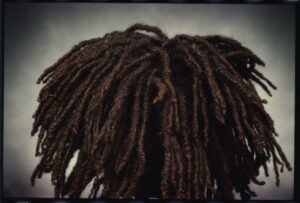
I realize that there’s a tension in my work sometimes between the subject and how I treat it. The aesthetics, rather (than) the ethical, the form, rather than the execution and the meaning itself gets lost, or at least complicated. But it’s that tension that to me makes me an artist because otherwise if it’s either clear or, you know, less ambiguous, it’s either one thing or another. But I find that it’s more interesting when it’s that and the other.
We have here a picture called Dread, from the 80’s, One of my first photographs and at the time I did what I considered tableau photography, meaning there’s a person, a backdrop or light, and it’s a picture of my friend Michael Coulter’s head. And I call it Dread because on the one hand there are dreadlocks, but on the other hand, the word dread means something. And in this case, it’s the fear. The fear of the unknown and the fear of black people.

Patrick McNally,
"The Hooded Men"
Torture
2015
Patrick McNally, "The Hooded Men"
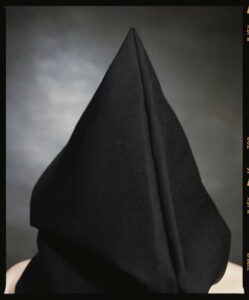
Well, the first time I thought about Torture was immediately after the Abou Ghraib. I was approached by a/political, an arts-based organization in London. So having their support, I spent several months looking at torture from different angles, including medieval torture instruments as well as individuals.
In this case, the hooded men who were Irishman who were tortured by the police. Because they were accused of being I.R.A. agents. When I photographed them many years later, I said to them that I wanted to photograph them with hoods over their heads. It had been a very traumatic experience for them. At first they were shocked by my request because they thought I wanted to do just portraits of their faces. But I said to them, they’re symbols and I wanted to recapture those hoods that they wore.
It’s another way for me to combine or to turn the person into a symbol with the use of clothing, in this case, masks, reflecting on, connection with the Klan’s people, connection with other people who have who I photographed in some sort of costume or robe where whereby they became a symbol as well as a person. For me, it’s more interesting to use real people, real Klans people, real dead people and stage photographs than it is for me to use actors in and stage them.

Cross
Torture
2015
Cross
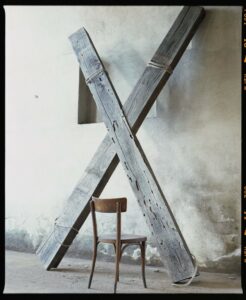
I’ve always said that as an artist who is a Christian, I use the symbols of my faith. And so I was always struck by the body and blood of Christ. And so as an artist, I use the symbols of the church. And for me, it’s not a conflict, it’s not an issue to use them in any way. I care, too. I mean, if you look at history throughout history, great artists who are now considered religious painters, even a painter like Hieronymus Bosch, they do all kinds of things with the church, with the people of the church and in their depictions of heaven, of hell. And so it’s not unusual for artists, particularly one who identifies as a Christian, to work with loaded images.
I think there’s a lot of confusion with my work as a Christian, as an artist. And what I do with the symbols of the church. Some people think I’m anti the church. I’m not anti-church. I’m not anti-anything.
It was very, very important for me to be invited to the to the Vatican last year, on the occasion of the 50th anniversary of the inauguration of the Vatican collection, I was one of 200 artists and writers and people, architects, people from all walks of life who went to hear the pope speak at the Sistine Chapel and then had a few seconds to greet him. And so that for me was a high point of my career.

Blood Madonna
Holy Works
2011
Blood Madonna
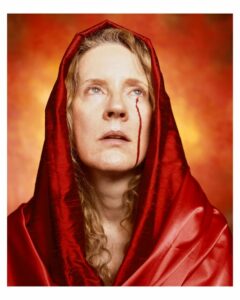
I think blood is particular, and blood when it comes to Christianity, is particular not to Americans necessarily but certainly to Christians. And it’s not unusual for blood to figure prominently in Christian works. And, I think that the church has had a mixed history of bloodied history. And many wars have been fought, in the name of God, not only Christian wars, but other kinds of wars. And so faith, it’s ironic, but faith often leads us to death. And so religion is, all religions are covered in blood.

El Gran Cabrо́n
Holy Works
2011
El Gran Cabrо́n
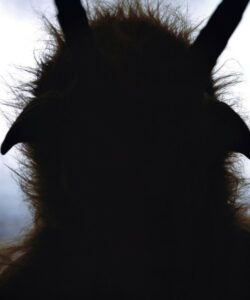
This image is called El Gran Cabron. And I was thinking of Goya’s work when I did that image. And I’ve always said I’m influenced by many artists, especially by Marcel Duchamp, who taught me that anything, including a photograph, could be a work of art. But, you know, I’ve been influenced by people like, artists like Picasso and the Spanish painters, Goya in particular. And so there I react to strong work and in terms, there’s an artist who he grappled with aesthetics and subject matter and provocation all at the same time. So it’s not unusual for an artist to balance everything altogether. You know, we juggle many balls and sometimes the results, you know, are better because they’re more complicated.

The Snake
Holy Works
2011
The Snake
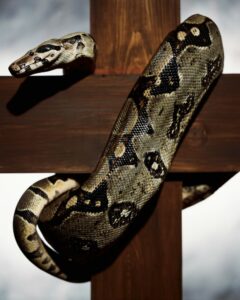
The say in the serpent and the cross, it goes back to the beginning of Christianity. It goes back to Adam and Eve. And so the serpent, I suppose, represents evil. It can also represent a life force that works inside the church, within the church and surrounds it. And I’ve always said you need evil to know good. You cannot have good without evil. You need the profane in order to know what’s sacred. And so these things, they work well together. They need each other.

Virginian Dragoon .44 Magnum VIII
Objects of Desire
1992
Virginian Dragoon .44 Magnum VIII
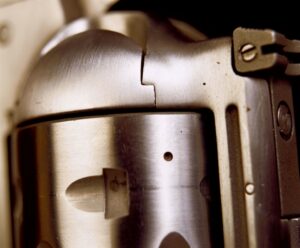
The Objects of Desire came about because I had gone to New Orleans to do a lecture and met a young artist by the name of Blake Boyd, I had befriended him, and somehow in conversation with him, he told me that his father was a, like a deputy sheriff and that he had access to these gun collections. I asked him ‘can you get guns?’ And so I made an arrangement, a few months later, to go back to New Orleans with the intent of photographing these collections of guns and calling them the Objects of Desire. Now, the gun symbolizes many things. And nowadays, particularly in America, when you have a serial killing almost every day, guns take on a different meaning than what I saw at the time when I photographed them. It wasn’t a statement about guns as weapons.These guns owned by collectors, gun collectors who have more than one gun. And whether or not they use them as in target practice or not, they value them, they cherish them, they polish them. And so there are many people who collect guns in America as collectors. Interestingly enough, I never met a gun collector that was a woman.

Milk/Blood
Bodily Fluids
1986
Milk/Blood
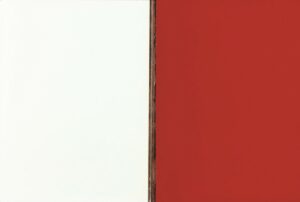
In 1986, I thought about creating an image that would be a fake painting, as a photograph. I did this picture called Milk/Blood. It’s a split screen : the left is a tank filled with milk, the right is a tank filled with blood. And it’s called Milk/Blood. It refers to Mondrian. And for me, this picture is radical and it explains everything that came afterwards, because without this picture, I wouldn’t have the Immersions. But this picture was meant to be a photograph that looked not like any other photograph : there’s no spatial relationship, there’s no perspective, there’s no backdrop, there’s no foreground, there’s no subject. There’s only color, it becomes a “color field” picture.
And from there, I went on to do the Piss and Blood picture. These are very abstract works using color, using these bodily fluids, milk, blood and later semen in a very flat way, a very non-representational way. And so that’s how those began. And at the time, I thought it was radical for photography because, as I said, there’s no subject matter. There’s only color. After Milk/Blood, I did a monochrome called Blood, it’s just a red picture. So again, it’s the idea of doing abstract works that are actually representational.

Piss Christ
Immersions
1987
Piss Christ
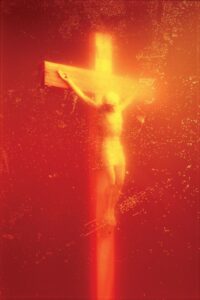
It’s funny because Piss Christ is my most known work, my most infamous work and people say “what were you trying to say with it?” And actually, I wasn’t even thinking about what I was trying to say. I just did it. Piss Christ is the first immersion, the first time I put and dropped an object into the bodily fluid. And it was piss, it was Christ, so naturally I had to call it Piss Christ. I wasn’t thinking about if it was blasphemous.
It’s a crucifix, particularly, and a rosary, it’s something that people handle. They rub it, they pray to it, they wear it. But they really don’t think about what it really means. And the crucifix, the rosary, it’s all you know, it’s a symbol. It’s a symbol of the way Jesus Christ died on the cross. And when he died on that cross for three days and the Romans, you know, they made sure that he was dead by probably stabbing him and putting a spear through him. Everything came out. All the liquids, the blood, the piss, the shit, everything came out. So if this Christ offends you in some way, if it attacks your sensibility in some way, maybe you should think about what the crucifixion actually symbolizes. It’s not this aesthetic little thing that you can carry around as a fashion item. You know, it symbolizes the death of Christ, which was a horrific way for anyone to die.
The first time it Piss Christ came into prominence was, you know, more than two years after I made it, when it was denounced in Congress in 1989. And because of the fact that there were so many senators and congressmen, people were upset about Piss Christ because they had been part of the exhibition and an award that I had gotten, not from the NEA, the National Endowment for the Arts, but from another organization that had funds.
[which/it] started the culture wars of 1989. And I have to say I’m very happy that if I provoke some kind of thought, even if I intended that it happened, because it means that the work is alive with meaning and also with problems for some people.

Semen and Blood III
Bodily Fluids
1990
Semen and Blood III
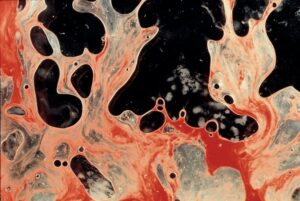
The Blood and Semen image is very important for me because shortly after I made it, Metallica saw it. Kirk and Lars from Metallica, they saw it and they asked me if they could use the image for one of the albums called Load and so happily, you know, this image became a Metallica cover. So I’ve done two Metallica covers, Load and Reload, and it’s another case where in a few weeks I’ll probably do a podcast for a Metallica podcast where they’ll ask me about this image. It’s, you know, the work comes back, even though I made it decades ago, it still has a presence. It’s still something that people want to talk about. And so I’m very happy to do that kind of work that I’ve always said I wish more bands would use my work for covers, but I’m happy that Metallica used my work for two of their best albums.
Before Metallica approached me. I didn’t know their music. I didn’t hear a lot of metal music, I was born with what they call classic rock’n’roll. The Beatles, Rolling Stones, Janis Joplin, Bob Dylan. So that’s my music, that’s the music of my youth. And so later on, I got into rap music. But once Metallica used my pictures, I became a Metallica fan.

Piss Discus
Immersions
1988
Piss Discus
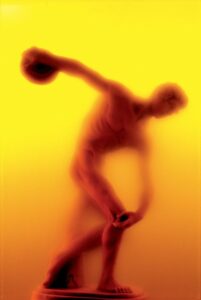
I made what people later called the Immersions, meaning I immersed an object into the fluid of piss, and the first immersion I made was actually Piss Christ. And from there I went to do others like Piss Discus and, you know, Ecce Homo.
Piss Discus is a very famous image, you know, from Antiquity. It’s a symbol of sports. It’s a symbol of the Olympics. And obviously. You know, even though I didn’t know at the time that I made the image that many years later, I would be having a show in Paris at the same time as the Olympics in Paris, it’s still, again, another instance where things from the past come to the present and will go on to the future. So there’s always a connection. Happily, there’s always a connection in my work to something that’s going on.

Hans and Frans
A History of Sex
1996
A History of Sex
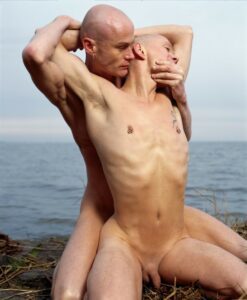
I like to make work that is accessible to people. You don’t have to have an art history. You don’t have to even know my work to get something from it, because you recognize something in the subject that has some relevance for you. I spent more than five months in Amsterdam in 1996. I looked at every aspect of sex in Amsterdam. I went to many sex parties, sex clubs and anything having to do with sex, you know, ideas, models you know, so. So that’s how I was able to do the work in Holland, because not only did I find subjects that were willing, I also found ideas that I wanted to explore.
Sex is a central issue of American culture, it’s one of the biggest issues, but, you know, America has a very strange relationship with sex, even though we’re known as a puritanical society. And in many ways, we still are, you know you cannot flash a titty on TV. I remember when Janet Jackson’s career was destroyed because of a titty flash during her performance on TV for the Super Bowl and it destroyed the woman’s career. By contrast, in Paris and in Europe, you can see a woman breastfeeding her child on a billboard and it’s not a big deal. So, America is very provincial when it comes to sex publicly, privately, it’s one of the biggest industries for pornography in the world, if not the biggest.

Homicide
The Morgue
1992
Homicide
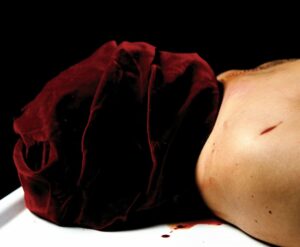
I had an idea in 1992 to take pictures of people who called John and Jane Doe, people who die without an identity. But I made inquiries and I found that it was difficult to get into a morgue. The opportunity presented itself, I met the person in charge of the morgue, and he said, “If you want to come here to photograph the dead, you can” with the understanding that their names would not be revealed and their faces would not be recognizable. And so for The Morgue, everything is titled by the cause of death.
Many people in America don’t have the same understanding of culture as they do in Europe and other places. Nudity is not a big deal in Europe. But last year, a year ago, you know, the statue of David caused the woman, a teacher and a principal to be fired in America because they showed the picture to some high school students. I mean, it’s outrageous how provincial Americans can be. It’s a great nation. It’s very sophisticated in many ways. But when it comes to culture, nudity and the body, it’s very different from other parts of the world.

Chuckling Charlie The Laughing Robot
The Robots
2022
Chuckling Charlie The Laughing Robot
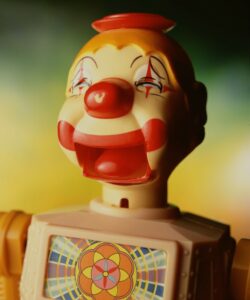
When I decided to do the Robots, I came up with a title or rather an idea : before the metaverse, there were robots. And robots for me, particularly these robots, many from the 1960s from the seventies and eighties, they were the stuff of childhood dreams. At the time, science fiction, starting with Metropolis and the word robot itself, which comes from « robota » word by a Czech playwright in the 1920s. In 1920, I believe, you know, the idea that robots or intelligent creatures, human-like but not human, it was all fantasy at that time. Later now with A.I., robots and artificial intelligence, it’s no fantasy now. In fact, it’s a scary reality.
But in my case, the robots that I photographed, I saw people in them. All of my works, in a way, are portraits of somebody, something, a symbol. But ultimately, it’s a portrait of me. And so these robots, I made portraits of them. And you can see whatever you want to see in them. Among other things, I see race because the robots come in different colors.So in a way, the robots are a race of creatures of both human and inhuman appearance. And whether or not they’re good guys or bad guys, only time will tell.

The Game: All Things Trump
2018 - 2019
The Game: All Things Trump
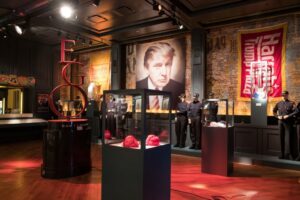
When I did The Game. All things Trump, I did it because Donald Trump was all I heard on the news. You know, he had just become president and the whole world was obsessed with Donald Trump. Anything he said or did was news. And having done a portrait of Donald Trump in 2004 from my America series, I decided to do a bigger portrait of Trump.
And so again, I had to collect and what I collected was probably about a thousand objects, all having to do with Donald Trump. His objects made for himself, for his casinos, his businesses, his hotels. And curiously many items in Donald Trump’s universe that he put his name on were mainstream products. He put his name on vodka. He put his name on everything he could.
And the thing about Donald Trump is that many of his businesses have failed, but that did not stop Donald Trump from putting his name on things. So even before Donald Trump became president, he was a great showman and he wanted the world to know who Donald Trump was. And once he became president, it was a daily thing. And one of the biggest objects in the game, aside from my portrait of Donald Trump that I made very big for the exhibition, is the EGO Sign. It came from the Trump Taj Mahal Lounge at Trump Hotel in New Jersey. And the word ego spinning around, that’s the personification of Donald Trump. Donald Trump is all about ego.

"Flag Face" Circa 1890 American Flag
Infamous
2019
"Flag Face" Circa 1890 American Flag
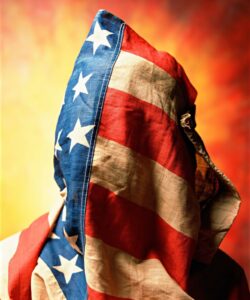
I think the last three pictures are very telling in terms of my work, but also in terms of what’s happening in America today. More than ever guns are an issue. It seems to be a particularly American issue. In America not only can you buy them, there are many states where you can go around with your gun in public. I don’t think it’s wise or safe for a black American to walk around with a gun in public, even with a license. So it’s a double standard. America has many double standards where one person of one race can do one thing, but not another.
Blood on the flag here on the right was an image that I made a few days after September 11th. I felt like a symbol of America at the time we were attacked. America bled for that one moment, bled at the hands of someone else other than itself. America has, of course, been at war with itself. And for many people, the Civil War never ended. It’s still going on.
And the image in the middle, it’s America. It’s a symbol of America in terms of a face. It’s a figure of a human, but it also assumes (it has) a shape like a Klan’s hood. You can read whatever you want into it, but to me, it’s like making a very ambiguous portrait of America because America is an ambiguous place; it’s both good and bad. And however, America used to be thought of as the policeman of the world, and I’m not sure we still have that reputation. I think a lot of people both inside and outside of America are questioning what America’s rôle is.

Pieta
Holy Works
2011
Pieta
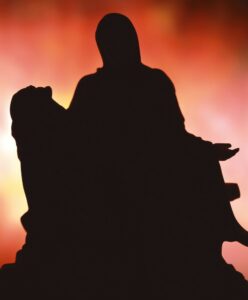
I went to art school as a kid. I was 17 when I went to Brooklyn to the Brooklyn Museum Art School for two years where I studied painting and sculpture. After two years, I felt I couldn’t really paint, but I lived with the girl who had a camera so I started taking pictures with her camera, but never saw myself as a photographer. You know, I’ve always said I’m an artist and for decades I chose to use photography as my art practice, as an artist, not as a photographer. Recently, the last year or so, I’ve been working on doing mixed media works, painting, acrylics that, even though they’re photo based sometimes, are based on classical statues or Michelangelo statues, they’re not photographs that I took, and when I paint over them, I create my own thing with them . Even if I haven’t used paint before, I paint it with colors, I’ve painted with ideas as an artist. And so that’s why I said the distinction is important : yes, I’ve created photographs, but don’t call me a photographer. I am one of these, that generation of photo based artists who used photography, you know, exclusively many times, but not consider themselves photographers.